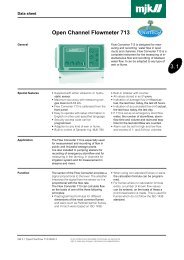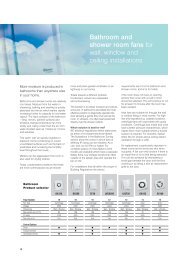Accessories - CMS
Accessories - CMS
Accessories - CMS
Create successful ePaper yourself
Turn your PDF publications into a flip-book with our unique Google optimized e-Paper software.
16<br />
Functions<br />
Dosing monitoring<br />
Applies to all DME and DMS-A(R) (0-48 l/h)<br />
Dosing stoke measured<br />
Monitor mounted on suction side<br />
(DME and DMS)<br />
The dosing monitor is designed to monitor the dosing of<br />
liquids which may cause gas accumulation in the<br />
dosing head, thus stopping the dosing process even if<br />
the pump is still operating.<br />
For every measured dosing stroke, the dosing monitor<br />
gives a pulse signal to the level input so that the pump<br />
can compare performed pump strokes (from internal<br />
stroke sensor) with externally measured physical<br />
strokes (from the dosing monitor). If an external dosing<br />
stroke is not measured together with the internal dosing<br />
stroke, this is considered a fault that may have been<br />
provoked by empty tank or gas in the dosing head.<br />
When used together with a DME pump, the monitor will<br />
only operate if it is mounted on the suction side of the<br />
pump.<br />
When used together with a DMS pump, the monitor will<br />
also operate if it is mounted on the discharge side of the<br />
pump.<br />
The dosing monitor should be connected to the level<br />
input (pins 2 and 3). This input must be configured to<br />
dosing monitoring. Consequently, it cannot be used as<br />
level input.<br />
Once the input has been set for dosing monitoring and<br />
a dosing monitor has been connected and set, the<br />
dosing monitoring function will be active.<br />
Definitions:<br />
• Correct dosing stroke: A pulse from the dosing monitor<br />
corresponds to the internal stroke signal within<br />
acceptable time.<br />
• Incorrect dosing stroke: There is no pulse from the<br />
dosing monitor corresponding to the internal stroke<br />
signal within the acceptable time (the pump is not<br />
pumping).<br />
Dosing stoke measured<br />
Monitor mounted on discharge side<br />
(DMS only)<br />
Dosing stoke measured<br />
DME and DMS<br />
Monitor mounted in dosing tube.<br />
In discharge tube: DMS (in-line)<br />
In suction tube: DME and DMS (in-line)<br />
Logic:<br />
If two incorrect dosing strokes are performed, the pump<br />
will continue operating, but it will change over to alarm<br />
mode. The red indicator light will be on and the alarm<br />
output, if any, will be activated (variant AR).<br />
For each correct stroke the counter is reset and the<br />
alarm output, if any, is deactivated.<br />
Operation in connection with vent valve:<br />
It is possible to add a self-acting solution for liquids that<br />
cause gas accumulation by using an automatic vent<br />
valve. The solution is the dosing monitor with a pump<br />
and an alarm output (control variant AR). The alarm<br />
output thus activates the vent valve, which will automatically<br />
vent gas accumulated in the dosing head. When<br />
the dosing head has been vented, the pump will start<br />
pumping again, the alarm output will be deactivated<br />
and the vent valve will close.<br />
TM02 2029 3201 - TM02 2030 3201 - TM02 2031 3201<br />
TM02 2048 4802

















